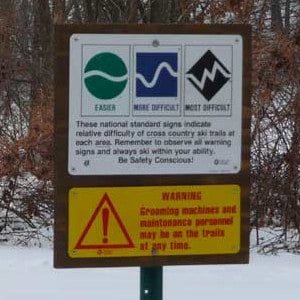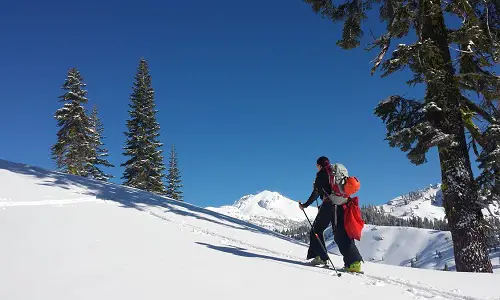Table of Contents
As a cross country skier, you need to know what the trail signs mean, how to understand the trail difficulty level, and how to ski responsibly. There are certain guidelines you must follow to keep yourself and other skiers around you safe, and you must be fully aware of things that you need to do in case there is an emergency.
Trail Difficulty Signs
You may have noticed that the cross country ski trails have often symbols showing the difficulty ratings. The best part is that these difficulty signs are somewhat universal so the standard signs can be found in different XC ski locations.
Easy Trail
Denoted with a green circle that has a flat line with a wavy stroke passing through it, the easy trail is also known as the easier trail, the easiest trail, or the beginner trail.
Intermediate level Trail
This is relatively difficult than the easy trail and is often referred to as the more difficult trail. It has a sign of a blue square, or sometimes a blue circle, with a wavy white line passing through it.
Expert Trail
It is also known as the difficult trail or often referred to as the most difficult trail and is represented using a black diamond with a zig-zag white line (that looks like a mountain range) passing through it. In some expert level trails, the black diamond sign is accompanied by a danger sign – a yellow safety symbol with a red border and a big red exclamation mark in the center, which means you have to be “extra careful” on this difficult trail.

Assessing the trail difficulty level is somewhat subjective. If you see the same board on two different trails, it does not mean that the two trails are identical. Their level of difficulty can be fluctuating, so it sometimes gets a bit confusing for a cross country to judge how easy or difficult a certain trail is. Having said that, the easier trails are generally the trails that are mainly flat with a couple of small hills, if any.
The intermediate trails which are more difficult than the beginner level trails generally have more dramatic terrain that includes having large hills with turns and/ or steep hills. The most difficult trails that are marked by the expert level trail symbol have an almost straight down hill pattern. However, if you are a pro who has skied on all kinds of terrain, you will notice that there are some black diamond trails at certain places which may not be more difficult than some intermediate level ones.
Again, the level of difficulty is someone subjective so consider the trail signs as general guidance and not an accurate mark of easy or difficult terrains. There are also some intermediate level terrains that are longer than an average intermediate level terrain and are therefore marked as being more difficult terrain. Here is the good news that can be helpful to you. At a certain resort, the cross country ski trail signs will be consistent (as compared to other parts of the country), which means that all the easy trails will be identical, the intermediate level trails will have similar length and level of difficulty, and the expert level ones will all be at a similar level of difficulty.

Understanding the difficulty level of a certain terrain is important for various reasons. As most of the groomed XC trails are one-way trails, once you start skiing, you cannot just turn back to the trailhead if you find them harder than your liking.
The trail levels are also marked by evaluating the snow conditions of that particular area. When there is ice on the trails, even the easier trails can get difficult to ski on. In icy situations, the black diamond trails can even become impossible to ski on. Therefore, keep an eye on the trail symbols. Also note that the color codes given to the level of difficulty – green, blue, and black – are different from the signs used for navigation on the trails.
Once you have arrived on a ski trail, take some time to read the trail map. Observe the colored symbols on the trails. They are there to help you and to make your skiing fun.
The Cross-Country Skier’s Responsibility Code
Being a responsible citizen is always important no matter where you are. But as a cross country skier, you need to be extra careful in following rules to make sure you stay safe, and other skiers are not put into any form of danger due to your actions.

The responsibility code of a cross country skier is primarily based on common sense and general ethics. Chances are that you already know the majority of these rules, but do you follow all of them? Even when you feel you are alone on the trail, make sure you follow the rules to be safe. Keep an eye on your surroundings and follow these rules:
- When skiing at a commercial center, always purchase your trail pass.
- Always keep an eye on the weather conditions as they will impact your skiing.
- Check the posted trail conditions, and obey the warnings and other signs.
- In case you want to stop in the middle of a trail, you must quickly step off that trail so the other skiers can pass. Do not stop in the middle of the hills or at a place that is generally not visible to other skiers. You should never block intersections.
- Be respectful of the skiing time allotted to you. Also, you must know your skiing abilities and choose a trail that matches your level of skiing.
- Always be aware of your surroundings – the trails, skiers, and anything that can affect your skiing abilities. Make sure you control your pace and the direction you are skiing towards. Be prudent enough to give yourself some margin in case you have to stop suddenly to avoid any kind of injury to yourself or other skiers.
- Use the proper devices to assist in preventing runaway equipment.
- On ski trails that are double tracked, keep to the right except for when you plan to overtake a skier.
- Skiers ahead of you have the right of way, so you must avoid getting too close to them.
- Pay attention to any skier calling out from behind. When a skier calls to pass, make sure you move to the right to give the skier proper room to pass. This is important for the safety of both of you.
- Footprints negatively impact the grip and glide so you are not allowed to walk in the tracks or the groomed trails. If you need to walk, keep to the side.
- Similarly, the ski trails are different for freestyle or skate and classic skiing. In case you are into skating, do not skate on the groomed trails that are exclusive for classic skiing. This will affect the glide and grip of the classic skiers.
- When starting to go downhill or merging, make sure you look uphill and yield.
- When overtaking or entering trails, do not cut off fellow skiers.
- Respect private property and stick to your trail, no matter how inviting and tempting a certain private property seems like. Also, keep away from closed trails.
- Make sure you know how to load yourself, unload, and ride a lift before getting on one.
- Respect the right of way of descending skiers when on hills.
- If you want to ski with your four-legged friend, only go to cross country trails that allow dogs.
- Do not litter and in case you are skiing at a dog-friendly trail with your dog, clean up after your pup.
When on a one-way trail, only ski towards the direction you are supposed to.
In Case of Emergency
You should be mentally prepared to deal with all kinds of emergency situations when on your cross country ski trail. You may encounter a situation yourself or may observe a fellow skier needing immediate help. In case of an emergency on a cross country ski trail, follow these rules:
- In case you encounter a skier getting injured and needing help, place a pair of crossed skis in the shape of “X” near the injured skier.
- Make sure to keep the injured skier warm.
- Do not move or drag the injured skier as it may add to his/ her injuries.
- Have a look around the trail for signs or landmarks that could help you determine your exact location.
- Call for help immediately.
- If you notice a fellow skier helping an injured skier, reach out to help him/ her.
It is important for you to stay calm and composed in case of an emergency. If you have encountered a collision, make sure you call for help. Keep the above points in mind. They may seem simple and commonsensical, but often in emergency situations, one gets clueless.
As long as you follow the basic guidelines to keep yourself and others safe and understand the meaning of trail symbols, you are guaranteed to have a great experience on the cross country ski trails. You need to be aware of your surroundings and help your fellow skiers in case they need any assistance. This way, everyone can have a great and safe skiing experience!


